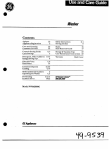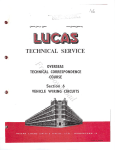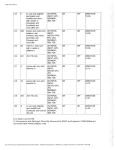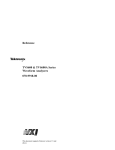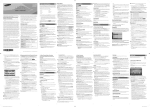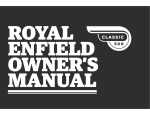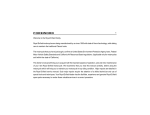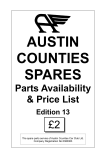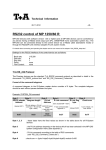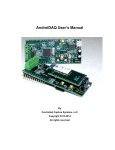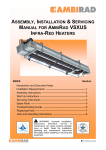Download STEERING - The Austin Somerset Coupé
Transcript
SECTION J STEERING NUMBER 1 DATE SUBJECT CHANGES AUSTIN A40 SERVICE MANUAL J/1 STEERING GENERAL DATA Type of Gear ... ... ,.. Cam and Lever ... ... 14 to 1 Steerhg Gear Ratio (Saloon) ... ... ... 12 to 1 Steering Gear Ratio (Sports) ... Bearings ... ... ... Ball Race akd Felt Bush Adjustrnent ... ... Screw & Packwood Shims Diameter of Steering Wheel ... 17-ins. (43.18 cm.) Turning Circle (Cars) ... . .. 37-ft. (1 1.278 m.) Turning Circle (Coinmercials) ... 38-ft. (1 1 .S82 m.) Track Toe-in ... ... fs-A-in. (1.5875-3.175 mm.) Austin Ball Type Steering Comections ... ... Fig. 1. A general view of the steering linkage for a right-hand model. On left-hand steering models the positions of the steering box and idler shaft are reversed. Description The steering gear. of "Bishop" design, is a selfcontained unit of extreme simplicity. The steering tube revolves a cam which in turn engages with a taper peg fitted to a rocker shaft. This assembly is enclosed in an oil-tight casing, which carries two ball bearings at either end of the cam. The bearings are designed to carry radial and thrust loads. When the steering wheel is turned the tube revolves the cam. which in turn causes the taper peg to move over a pre-determined arc, thus giving the rocker shaft its desired potion. Attached to the rocker shaft is a double lever which links up with the steering linkage. The steering linkage is of the "three cross-tube" type, having a centre cross-tube connecting the steering gear double lever to the arm on the idler shaft. Two shorter cross tubes, one on either side, connect the steering arms to the steering gear and idler levers respectively. These two shorter cross-tubes are more generally referred to as side tubes. 512 STEERING Maintenance Lubrication of the oil nipples on the steering connections and swivel bearings is most important to maintain accurate steering. Approximately every 500 miles, use the oil gun and recommended oil to charge the following points with 1ubricant:- (a) Steering side and cross-tubes-6 nipples. (b) Lower wishbone arm outer bearing-2 nipples. (c) Swivel pin bushes-4 nipples. (d) Steering idler-1 oil filler plug. The steering gear should be topped up with recommended oil to the top of the filler plug opening approximately every 5,000 miles. STEERING CONNECTIONS AND IDLER Adjusting the Track The track is best checked by means of the Dunlop Optical Alignment Gauge No. 9, particulars of which can be obtained from the Dunlop Rubber Company Limited, Fort Dunlop, Erdington, Birmingham. The cross-tube is threaded right-hand at one end and left-hand at the other, so that the track adjustment can be made by simply rotating the tube in the required direction after releasing the locknuts. On some models the adjustment is secured by clainps and pinch bolts. Under no circumstances should the setting of those side-tubes that are adjustable, be disturbed for tracking purposes except after a dismantling of the steering link- ages. They should then be reset to 11%-in. measured between the ball pins. Always re-tighten the locknuts at each end of the cross-tube after an adjustment has been made. Side and Cross-Tubes The side and cross-tubes are held in position by a castellated nut and split pin at each end. On later models a washer is fitted beneath the castellated nut. It is essentia1 that this washer be replaced on reassembiy, otherwise the nut, when tightened, will be screwed too far down the thread to enable the split pin to lock the nut in position. Fig. 2. Chxking the wheel track with the Dunlop Optical Alignment Gauge No. 9. A. Wheel pointer. B. Attachment hook. C. Mirror. D. Calibrated scale. E. View box. STEERING Fig. 3. The toe-in rnust be adjusted rothat A is inch less than B. 6 to 1I J/3 a very fine adjustment. Adjustments should be made and checked regularly, otherwise undue slackness will cause a deformity of the ball pin thereby making further adjustment impossible. To make an adjustment, remove the split pin, lightly screw it back to the first alignment of the split pin hole and castellation. The ball should then be able to move freely in the socket. Always ensure that the rubber boot fits snugly in the groove provided for it in the tube end. An alternative type of connection is employed on some models. This type is self-adjusting and requires no attention other than lubrication at the prescribed intervals. To remove the tubes, witlidraw the split pin and release the nut at each end of the tube and then carefully tap the tubes clear of the levers to which they are attached. When removing one of the connections from either end of the steering gear double lever, always support the lever to prevent any shock from being transmitted to the steering gear where damage may be caused. Tube Connections Some steering side and cross-tubes are equipped with the Austin patent ball and socket connections which are screwed into the ends of the tubes and can be adjusted to take up wear. These connections consist of a threaded and castellated lower socket screwed into position and locked by a split-pin. The body of the tube-end has four split pin holes drilled, vernier-pattern, at a different pitch from the castellations in the socket, thus permitting Fig. 5. Showing the adjustable type of the Austin patented ball and socket connection. Removing- the Double Levers These are held to the steering gear rocker shaft and to the idler shaft respectively by a nut and split pin. With the removal of the nut and split pin, the double levers can be withdrawn from their splined shafts by using an extractor. See Fig. 1 l. Never attempt to lever or hammer the steei-inggear double lever from the rocker shaft, otherwise serious damage to the steering gear may result. Fig. 4. Illusirating the self-adjusting type ball and socket connection. Removing the Idler With the side and cross-tubes disconnected the idler can be detached from the chasis. It is secured by three bolts, inserted from the inside of the dumb-iron and terminating in the three tapped holes in the idler flange. Support the idler with the hand and unscrew the setscrews until their threads are clear of the holes, when the idler can be detached. phosphor bronze bushes. At its lower end the shaft incorporates a spline to take the double lever and a portion of screw thread to take the lever securing nut. The idler shaft is drilled for passing lubrication to the bearing bushes. No adjustment is necessary for this type of idler. Refitting the Idler The refitting of the idler is generally a reversal of the removal procedure, but care should be taken to ensure that it is secured firmly against the frame by means of the three bolts with spring washers beneath their heads. Refitting the Double Levers There is a location mark in the double lever and a corresponding mark on the end of the steering gear rocker shaft. When refitting the double lever make sure that these marks coincide. Press the lever on to the splined shaft and sedure it with the castellated nut, plain washer and split pin. To check for the correct fitting of the lever, ensure that there is a distance of approximately 3-ins. between the underside of the frame side member and the upper machined face of the rear arm of the lever. Press the lever on to the splined shaft and secure Fig. 6. Steering idler parts explodd Cap setpin and washer. 8. Washer. Idlrr cap. 9. Double lever. Oil plug. 10. Slotted nut and pin. Joint washer. 11. Washer. Idler body. 12. Lower bush bearing. 6. Idler shaft. 13. Upper bush bearing. 7. Cork seal. l. 2. 3. 4. 5. Dismantling and Assembling the Idler The idler top cap is secured to the body by three setpins and has a joint washer inserted between cap and body. Lubrication is effected by removing the oil plug in the cap and injecting oil into the body. Internally 'the body' has a recess in the head and a plain bore right through. Twp phosphor bronze bush bearings, with interna1 oil grooves, are pressed into position, one at the top and the other at the bottom of the body. At the lower end of the body a cork sea1 butts up to the lower bearing bush and is retained in position by a steel washer, which in turn, is secured by the bore of the body being "peened" ovqr. By removing this burr, with the aid of a hand scraper, the washer and cork sea1 can be extracted. The idler shaft can be removed by hand once the body cap has been released. The flange of the idler shaft locates in the recess within the body head and the two highly finished portions of the shaft rotate within the Fig. 7. Checking the alignment of a swivel arm (method 2). STEERING J/5 it with the slotted nut, plain washer and split pin. Note that location marks are not necessary for this lever and shaft, but the clearance between the underside of the frame member and the rear machined face of the lever should be the same as for the lever fitted to the steering box shaft. The wheels must be in the straight-ahead position while these two levers are being fitted. Refitting the Side and Cross-Tubes First connect the two side-tubes to their respective steering arms and levers. Fit the cross-tube and ensure that both the side and cross-tube securing nuts are tight and split pinned. Swivel Arms The swivel arms connecting the swivel axles to the steering side-tubes may be checked for misalignment in the following way:(1) Place a rule along the brake backplate so that it projects alongside the arm. The distance between the centre of the ball pin locating hole and the rule should be 4-in. plus or minus Ig-in. (2) Place a straight-edge across the centre of the bolt holes used to secure the arm to the swivel axle. The distance between the straight-edge and the lower face of the arm machined face against which the ball pin nut fits-should be &in. plus or minus Ig-in. (See Fig .7.) Removing the Steering Gear To remove the steering gear and column complete from the car, first remove the upper portion of the direction indicator control tube from within the steering column. Release the three grub screws which pass through the steering hub to secure the horn quadrant. At the steering box end of the column, the horn and indicator electrical cables should be disconnected at the nearest snap connections. The horn quadrant and short stator tube may then be withdrawn complete with cables. It will be noticed that the short tube has a number of indentations on its outer diameter, thus forming lugs internally, which locate in the slot of the long tube remaining within the steering column. Finally remove the locknut retaining the steering wheel in position. With a sharp jerk upwards the wheel may be freed from the splines and so removed from the column. The gear change lever and rod are secured to the steering column by means of a clamp bracket, therefore the gear change must be released from the steering column. This operation simply entails the removal of the two Allen screws from the bracket. Fig. 8. Checking a swivel arrn for misalignrnent lmethod 1). Holding the steering column in place within the body there is a "U" bracket which is secured to the underside of the fascia panel. To dismantle this bracket, release the two setpins and remove the "U" bracket complete with its packing. Next jack up the car at its front end and remove the bumper and apron, two operations that have been detailed under the Bodywork section of this manual. (In the case of the Sports and Commercials, it is only necessary to remove the front number plate.) Remove the double lever from the rocker shaft, as previously described. Finally disengage the steering box from its mounting by removing the single nut and bolt and relative washers, and the two rear setpins and spring washers, al1 of which pass through the chassis side members, to the steering supporting bracket. The steering gear complete with column may now be withdrawn from the car by an outward movement and a slight twisting to avoid the bodywork. When replacing the steering, reverse the removal procedure but do not tighten the box securing setpins and single bolt, until the column has been secured within the driving position. STEERING 516 Fig. 9. Componenb of the studng b x . 1. 2. 3. 4. 5. 6. 7. 8. 9. 10. Wlt washer. Circlip. Cork washer. Steering inner wlumn. Top cover setpin. Rocker shaft adjusting screw. Adjusting screw locknut. Top cover. Joint washer. Steering gear housing. I 1. Rmker shaft arm. 12. Peg for rocker a m . 13. Steering gear bracket. 14. Setpin and washer. 15. Bracket clamp bolt. 16. Clamp bolt locknuts. 17. Ball cups for bearings. 18. Ball and cap assemblies 19. Cam. 20. Joint washer. 21. M n g adjustment s h h s 22. End cover. 23. 24. 25. 26. 27. 28. 29. 30. 31. 32. Setpin and washer. Trafficator tube gland washer. Trafficator tube securing nut. Filler plug. Filler plug washer. Cork washer. Retaining disc. Double lever. Washer. Slotted nut. -- STEERING 517 7 Dismantling The top cover plate should be removed after extracting the three securing setscrews. Tum the steering gear over and suitably support the top face leaving the rocker shaft free to be lightly tapped out using a soft metal drift. The following peg is a drive fit in the rocker and need not be removed unless showing an appreciable amount of wear. Adjusting the Gear The adjuster in the cover plate should be clackened by releasing the locknut and unscrewing the screw a few tums. The cover plate can then be fitted making sure an oil-tight joint is obtained. The adjuster should be screwed down until there is no free movement in the straight ahead position of the gear and the adjustment secured by the locknut. Final adjustment should be made once the gear has been reassembled to the chassis. It should be noted that as wear in use is normally greater in the straight ahead position than on lock, provision is made for this in the design of the cam, and it will be found that there is a slight end play towards each lock. It is essential, therefore, that adjustment should be made in the straight ahead position to avoid the possibility of tightness. The steering gear should be fiiled with recommended gear oil via the filler plug situated at the rear righthand side of the steering box and then a final test made to ensure that the movement is free from lock to lock. Fig. 10. Using Service Tool 18G 70 to withdraw a tight stecring whecl. Remove the four setpins securing the end cover plate in position, and release the end cover. The complete unit should now be up-ended with the steering box uppermost. By bumping the end of the inner shaft on a block of wood, placed on the floor, the worm with its two ball bearings will be displaced. The complete inner column can then be withdrawn from the casing through the open end of the steering box. For extracting the felt bush at the top of the column, use a piece of strong hooked wire, the hook pulling on the under face of the bush. The fitting of a new bush is simple ; smear the felt with heavy oil and press into place. Adjusting shims should be fitted behind the end cover so that there is no end play on the column, but at the same time they should not be pre-loaded, otherwise damage to the ball races may ensue. The rocker shaft may now be dropped into position, ensuring that it is a good fit in its housing and that the oil sea1 at the lower end of the trunnion is making good contact. HM. ase. A. Fig. 11. Using .%i.vice Tool 1 8 6 75 to remove a double lever. J 18 STEERING STEERING FAULTS If steering faults are not attributed to adjustment of the gear, they may fall into one of the following categories. Lost Motion The amount of lost motion reaches its maximum at either lock, but this is not normally felt at the steering wheel, since the geometry of the steering always tends to return the steering gear to the straight ahead position. Excessive lost motion in the steering gear will result in unsteady steering, knocks and backlash al1 of which can be felt at the steering wheel. This defect may be attributéd to loose steering connections throughout the linkage. Tight Steering If the steering is tight, disconnect the steering tubes and test the feel of the steering wheel. Stiffness may be due to the steering column being pulled out of line and this can be verified by loosening the column supporting bracket under the fascia and allowing the column to find its free position. Should the steering still be stiff check whether this is so in al1 positions. If so, the cause may be:(a) The direction indicator tube is fouling the column. (b) The felt bush at the top of the steering column is too tight. (c) The steering tube is bent. To ascertain whether the direction indicator tube is fouling the column, withdraw the indicator tube as previously described. Turn the steering wheel and if the stiffness has disappeared, it will probably be found that the indicator tube is bent, thus requiring a replacement. Should the steering still be stiff with the indicator tube free, withdraw the steering wheel and check the tightness of the felt bush and renew, if necessary. If the bush is free but the steering remains tight, remove the bush and check whether the steering column pulls heavily to one side. The inner column is fairly flexible and slight pulling to one side has little or no effect on the feel of the gear, but it may be that the column is bent thus giving no alternative but to renew the column. Fig. 12. Seclional views oí the steering gear. l . Felt bush. 2. 3. 4. 5. 6. Steering inner colurnn. Steering gear housing. Ball cup for bearing. Rall cage-inner. Cam. 7. 8. 9. 10. I l. 12. Ball cage-outer. Ball cup for bearing. Joint washer and shims. End cover. Securing setpin. Rocker shaft. 13. 14. 15. 16. 17. 18. Tdp cover setpin. Rocker armpeg. Rocker shaft adjusting screw. Rocker shaft bearing. Double lever. Securing nut. STEERING Loose Steering Loose steering is invariably attributed to end play of the inner column, which can be rectified by the removal of shims located behind the steering box end cover plate, in a manner already described. To check for this end float, disconnect the side and J19 cross-tubes from the double lever and turn the steering partly to the right or left lock. Then with the steering wheel held to prevent it from turning, endeavour to tum the double lever. Should the steering wheel have a tendency to lift, it may be assumed that there is end float of the gear.










